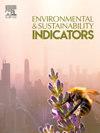Ecosystem services in giant panda habitats and the Giant Panda National Park: A decade of insight (2011–2021)
IF 5.4
Q1 ENVIRONMENTAL SCIENCES
引用次数: 0
Abstract
The giant panda habitats, especially the Giant Panda National Park (GPNP), play an important role in China's “Two Screens and Three Belts” ecological security strategic pattern. This study evaluates the effectiveness of ecological restoration in giant panda habitats by comparing the differences in land use structure, quantity, and ecosystem service value (ESV) between the GPNP and non-GPNP areas within it from 2011 to 2021, and the possible driving factors behind ESV heterogeneity are revealed. Our findings uncover profound implications of the national park pilot scheme on ESV in giant panda habitats: a remarkable increase in ecological land, reaching 1430 square kilometers, with non-ecological land primarily converted into ecological space through reforestation and afforestation initiatives. The ESV within GPNP displayed a distinctive trajectory, initially declining then rebounding, predominantly driven by forest land and water. In GPNP, natural factors predominate as chief ESV contributors. Contrarily, the surroundings experienced varying influences from both natural and human activities until 2015, followed by a distinct shift in ESV regulation under the GPNP's establishment, suggesting a dominance of natural factors afterward. This research highlights the positive impact of establishing a national park, not only enhancing ESV within its boundaries but also spillover effects on adjacent habitats, culminating in a consistent ESV uplift across the study area. These findings contribute valuable insights into understanding the restorative effects of the GPNP and inform the broader strategy for ecological conservation and management.
大熊猫栖息地和大熊猫国家公园的生态系统服务:十年洞察(2011-2021)
大熊猫栖息地,特别是大熊猫国家公园,在中国“两屏三带”生态安全战略格局中发挥着重要作用。通过比较2011 - 2021年保护区与非保护区的土地利用结构、数量和生态系统服务价值(ESV)差异,对大熊猫栖息地生态恢复效果进行了评价,并揭示了ESV异质性的驱动因素。研究结果揭示了国家公园试点对大熊猫栖息地生态空间的深远影响:生态用地显著增加,达到1430平方公里,非生态用地主要通过再造林和植树造林转化为生态空间。在森林用地和水体的驱动下,生态环境价值呈现出明显的先下降后回升的变化趋势。在GPNP中,自然因素是ESV的主要贡献因素。相反,直到2015年,环境经历了自然和人类活动的不同影响,随后在GPNP建立后,ESV监管发生了明显变化,表明自然因素在之后占主导地位。该研究强调了建立国家公园的积极影响,不仅增强了其边界内的生态环境价值,而且对邻近栖息地产生了溢出效应,最终导致整个研究区域的生态环境价值持续上升。这些发现有助于理解GPNP的恢复效应,并为更广泛的生态保护和管理战略提供有价值的见解。
本文章由计算机程序翻译,如有差异,请以英文原文为准。
求助全文
约1分钟内获得全文
求助全文
来源期刊

Environmental and Sustainability Indicators
Environmental Science-Environmental Science (miscellaneous)
CiteScore
7.80
自引率
2.30%
发文量
49
审稿时长
57 days
 求助内容:
求助内容: 应助结果提醒方式:
应助结果提醒方式:


